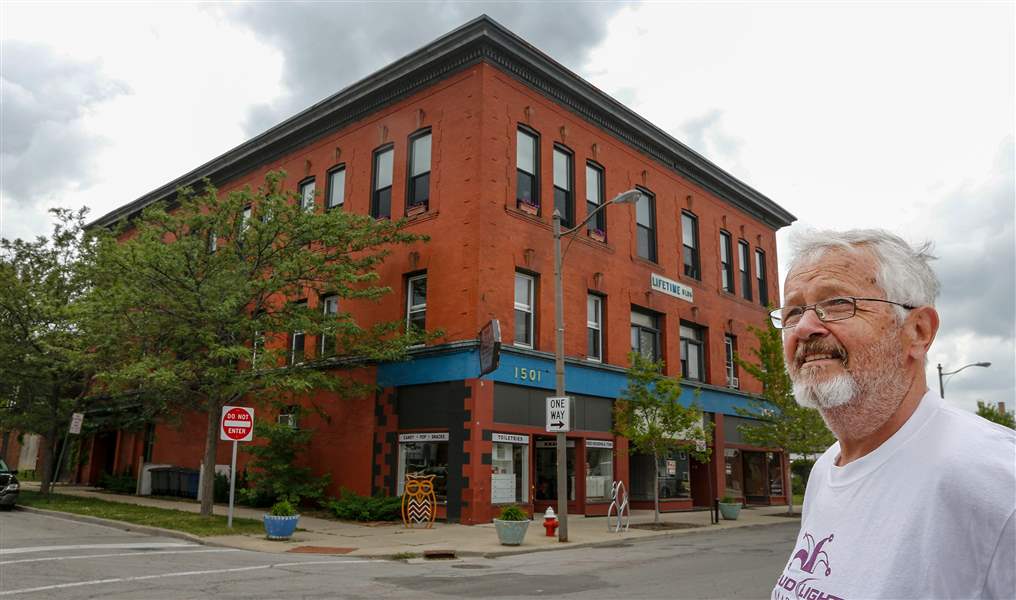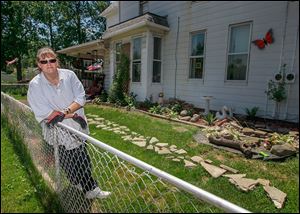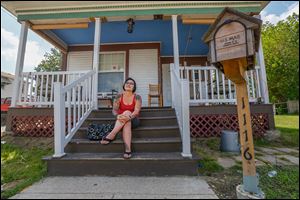
SPECIAL REPORT: THE UGLY TRUTH ABOUT TOLEDO
Can Toledo do better?
For some intrepid residents, the answer is a resounding yes
6/15/2014
Landlord Bob Cready stands in front of his building on Adams Street in the Uptown neighborhood near downtown. Tenants now live where accountants once worked in the 19,000-square-foot building. You can’t put elbow grease into your property without the city sticking its nose in your business, he says.
THE BLADE/JEREMY WADSWORTH
Buy This Image

Landlord Bob Cready stands in front of his building on Adams Street in the Uptown neighborhood near downtown. Tenants now live where accountants once worked in the 19,000-square-foot building. You can’t put elbow grease into your property without the city sticking its nose in your business, he says.
“You will do better in Toledo,” the old slogan goes.
Folks in blighted neighborhoods say, “You can do better, Toledo.”
Tongues wag. Toledo should have prevented the widespread urban decay. The city should pay residents to fix up their homes. Elected officials should partner with taxpayers to make a difference, a real difference. And be swift about it, or the city might as well hang “Sorry, We’re Closed” signs at Toledo’s city limits.
Even as blight crashes in on the community, pockets of populated areas bloom with the optimism of renovation and preservation.
Property owners, energetic and enthusiastic, are hammering out — and sawing, painting, polishing — a community comeback.
The Ugly Truth About Toledo page
Join the conversation by sharing your thoughts and photos of Toledo. Remember to note the location your photo was taken, and to include #UglyTruthToledo somewhere in your tweet, Facebook post, or Instagram photo. You can also e-mail your photos to uglytruthtoledo@theblade.com.
Tackling the issue
In her Old South End neighborhood, Lisa Oehmke, 42, plants flowers and ideas.
“This is a prototype,” she said, showing off improvements to a house she rescued at Walbridge Avenue and Courtland Avenue. She wants to stop the tear-down mentality. “Save the houses. Fix them up. Give them to veterans. Give them to the poor.”
Faced at times with a tangle of murky ownership and liens and back taxes, people can be quick to give up, but she’s staying put. Much work needs done.
She and other residents blast the city over what they call progress-stopping rules. Get with us or get out of our way.
Mother of five children, Mrs. Oehmke said she hires gang members to help with renovation and landscaping work, and in turn, she gives them job references. A bonus: Gang members keep an eye on the property they are bringing back from the brink of blight. See? Ms. Oehmke said. Community pride rubs off on young people. Just give them a chance to get involved. A place, a purpose.
On her wrist, a bracelet: Change the World.
Across town, 41-year-old Claudia Collins in 2000 purchased an 1866 home on Michigan Street near Elm Street where you could see the sky from the upper floor. She and her husband Mark, who works for CSX, have since made repairs on their owner-occupied home in the north end. “It is sad so many old homes get burned and torn down,” she said.
Local people seem to lack interest in investing in Toledo because blight is so pervasive, she said, adding community residents have lost faith in the city.
Yes, on days of desperation she wants to yank out every strand of hair on her head. There are times she wants to quit, pack up, leave. But she is as fiercely determined as she is outspoken.
“There is hope for Toledo. I think the city should give people more of a chance,” she said.
Common sense
Exactly, says Bob Cready, a landlord who lives and owns property in the Uptown neighborhood near downtown. “The city sends a task force to personally inspect buildings. It’s all about the city getting money through court costs and fines.”

Lisa Oehmke is fixing up this house at 404 Walbridge Ave. in the Old South End. She and others criticize the city over what they call progress-stopping rules.
That, he said, is not the way to approach nuisance abatement. “And the city wonders why nothing gets done. We need someone with common sense to step in. We have a city with knee-jerk reaction. ... ‘Let’s tear something down,’ ” he said.
You can’t put elbow grease into your property without the city sticking its nose in your business, he said. Stop-work notices get issued as property owners try to make things better, he said. “That’s the [expletive] you have to put up with.”
Informally, he calls his place the Bob Building, but the formal name is the Lifetime Building. Business in the building was shuttered; now, tenants live where accountants once worked in the 19,000-square-foot building.
He says he’s proud of the work he’s done in spite of the city. The city, on the other hand, says permits give authority for inspections that can save lives, such as by detecting faults in installation of a furnace.
Mr. Cready points with pride to the tree-lined area along Adams and 15th streets. He cuts grass regularly to improve the neighborhood’s curb appeal. And, he’s created an oasis of splendor near his building where he lives with two cats and two dogs.
Such a treasure — rain barrels, trumpet vines climbing up the side of a pergola, outdoor seating areas, pear and apple trees, a place to relax and to play — is like hope rising from ashes. Mr. Cready chuckles at his presumptuousness. “I built bleachers,” he said, a place where visitors, including his tenants, can watch area residents partake in games of Petanque, similar to bocce.
Exclamation points punctuate his words as he talks about changes that literally alter the atmosphere of a neighborhood. The entire city would benefit from a blitz on blight, he said.
A downsized city
Blight is nothing new to Toledo. It’s been a plague, spreading from neighborhood to neighborhood for years.
Issues of blight relate to what Chris Zervos calls the successful downsizing of Toledo. The city’s economy is still robust, he said, but the population has declined. It makes sense that Toledo now has too many structures, residential and otherwise, said Mr. Zervos, the city’s director of inspection.
Vacant homes can lower neighborhood property values, increase fire risk, and invite vandalism, crime, and other problems. A 2008 study released before the height of the housing crisis estimated that vacant properties cost Toledo taxpayers at least $3.6 million annually.
To critics who tsk-tsk demolition, Mr. Zervos has this to say: If the house was so valuable, someone would have purchased it.

In 2000, Claudia Collins purchased this home at 1116 Michigan St., where you could see the sky from the upper floor. She and her husband Mark have since made repairs on their owner-occupied home in the north end.
Toledo, he said, is doing its best to repurpose buildings. However, the reality is, some structures are past their usefulness, such as houses lacking amenities sought by home buyers today: attached garages, bedrooms on the first floor. “Those homes no longer meet the needs of people looking for homes,” he said.
Unless the population is increasing, it is difficult to find a use for those structures.
Vacant, abandoned structures are demolished in partnership with the Lucas County Land Bank, he said. Demolition, one way to attack blight, thins out tight quarters that can cause complaints.
Complaint-wise, the numbers come in at about the same pace year after year and can be predictable seasonally, such as grumbles about tall grass.
Predictable, too: complaints because we’re human. “A lot of neighbors hate each other,” Mr. Zervos said matter of factly. Neighbors complain about fences, critters, barking dogs, etc. etc. etc. Consider: Houses thisclosetogether can trigger a too-close-for-comfort atmosphere rather than a tight-knit community.
With only so much room between houses, a ladder set up to allow a homeowner access to gutters might be an inch or two onto a neighbor’s property. Then the howling begins.
Blighted homes include structures built during Toledo’s population explosion from 1880 to 1920, when the number of residents soared from 80,000 to 220,000, Mr. Zervos said
Back in the heyday, when Toledo’s central city and its west and east sides were being built, houses — nestled side by side by side — were intended for workers, younger people with families. It was a pedestrian era. People walked to work. “That is why there are so many houses built around factories,” he said.
As houses get taken down, opportunities go up for neighbors who could purchase extra land for a garage or green space.
Age of homes and residents can add to the blight. As the saying goes: Old Mrs. Miller died and went to heaven but her home went to hell.
Neighbors might say that Old Mrs. Miller was a fine neighbor, a sweet lady, but then her heirs, who perhaps live out of state, abandon the house. Eventually, instead of a property owner’s problem, it becomes a city problem.
Easy to find
The city devotes a large amount of resources to the removal of blight, Mr. Zervos said.
That said, blight is easy to find.
Along Starr Avenue on Toledo’s east side, you wonder if Madam Rose foretold the closing of her Psychic Center ... and not just the center, but business after business, building after building in that neighborhood.
Paul Sullivan, an architect who lives and works in Toledo’s Warehouse District, said he would like to see the city “save our wonderful neighborhoods and historical structures. Every effort needs to be put into renovating and saving as much as we can. You want to respect what the neighbors want. I think tearing down is an easy solution, an easy way out. It doesn’t really resolve the issue; it simply camouflages it.”
He lists issues: Absentee landlords, home ownership vs. rental, and the happy feel the city gets when it spends federal dollars.
Some structures, he said, are beyond saving, but the city needs to recognize that if Toledo wants to move forward, it has to save whole neighborhoods. That goal can be reached, he said, with a preservation ethos that starts with ways to reuse and renovate.
In Toledo, in spite of roadblocks and setbacks, residents celebrate as they see change happening. One window at a time, one roof at a time.
Drunks who stagger the streets are not the ones who will make changes, said Mrs. Collins from the front porch of her home. The city should invest in residents willing to improve neighborhoods, she said. Encourage, rather than discourage, property owners.
“It’s motivating,” she said. “Everybody needs that little push.”
And by working together to fight the blight ... it could be possible after all. You will do better in Toledo.
Contact Janet Romaker at: jromaker@theblade.com or 419-724-6006.